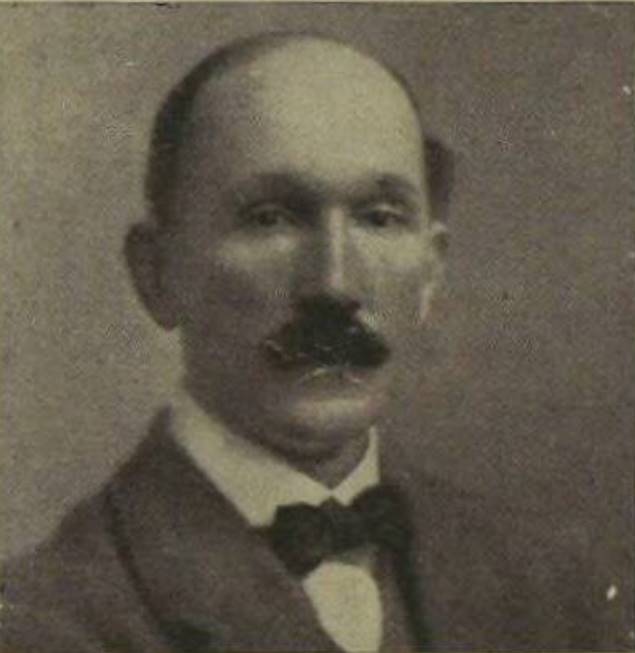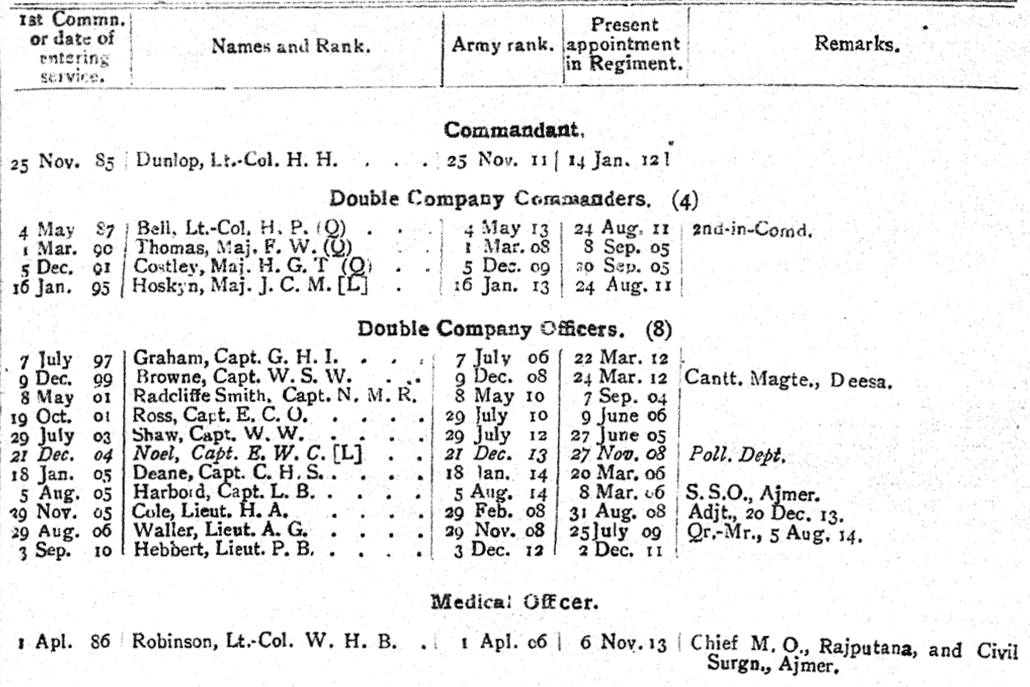This article will provide an overview of the activities of the 44th Merwara Infantry during the First World War and will help you research those who served with the Regiment. I have also written a series of guides to help you research those who served with the Indian Army during the First World War:
The 44th Merwara Infantry in the First World War
Lineage: Raised at Beawar by Captain H. Hall in 1822 as the Mhairwara Local Battalion. In 1823 it became the 14th (or Mhairwara) Local Battalion and the 9th (or Mhairwara) Local Battalion in 1826. Then in 1843 the Mhairwara Battalion, and the Ajmer and Mhairwara Police Corps in 1861. The Mhairwara Battalion in 1871 and finally the 44th Merwara Infantry in 1903. The Regiment was disbanded on 22 June 1921.
Class Composition in 1914: 4 Companies of Mers and 4 of Muslim Merats. 1919: 2 Companies of Mers, Muslim Merats and 2 Companies of other classes of Rajputana.
Location in August 1914: The Regiment was at Ajmer (Rajasthan, India) having arrived on 27 April 1871 from Beawar (Rajputana, India).
The 44th Merwara Infantry was an Indian regiment which spent four years serving in Mesopotamia (Iraq) during and after the First World War. When Britain declared war on Germany on 4 August 1914, the Regiment was stationed at Ajmer, in the present day Indian state of Rajasthan. In early 1914, the 44th Merwara Infantry was inspected by Major-General Kenneth Stewart Davison, commanding the Nasirabad Brigade in which it was serving. The Brigade was part of the 5th (Mhow) Division. This was its final confidential report before the outbreak of war and Davison’s comments are transcribed below:
Turn-out: Regiment well turned out.
Efficiency in drill and manoeuvres: Drills steadily and manoeuvres well.
Musketry: Well taught with good results.
Signalling: Good.
Equipment: In good order and well cared for with the exception of rifles, the barrels of which are much worn.
Personnel: British and Indian officers efficient and fit for their several positions, rank and file of good physique, powers of marching above the average.
Fire control and discipline: Satisfactory
Conduct: Good
Health: Good
Recruits: Of useful stamp, promise to become efficient.
Interior economy: Quite satisfactory. Due economy is practised as regards clothing deductions.
General efficiency: Regiment generally efficient and fit for service.
Confidential review reports on Indian Army units for 1913-14: IOR/L/MIL/L/17023.
The confidential reports also contain the annual reports on British officers serving with the Regiment when it was based in India. These are key documents for researching British officers of the Regiment and Captain George Graham’s is transcribed below.
The Regiment remained at Ajmer until 28 January 1915, when the unit boarded a train to Bombay (Mumbai). Arriving at Bombay two days later, the 44th Merwara Infantry immediately embarked on board the SS Varsova and SS Arancola. The Varsova sailed via Karachi and by 7 February, the entire Regiment had arrived at Basra, in what was Mesopotamia, now Iraq. The Regiment initially served with the 12th Indian Infantry Brigade, 12th Indian Division before it moved onto the lines of communication. Just prior to being moved onto lines of communication duties, the Regiment was involved in a disastrous engagement outside Nasiriyah.
On 7 February 1916, the Regiment was part of a covering force along with half the 90th Punjabis, a squadron of the 33rd Queen Victoria’s Own Cavalry and the 1/2nd Sussex Battery, Royal Field Artillery. These units were based in Nasiriyah and were to help cover the withdrawal of an Anglo-Indian force at Butaniya, twelve miles to the north. While the Butaniya detachment managed to withdraw in good order and passed through the Nasiriyah detachment, mounting Arab fire caused the 44th Merwara Infantry to break. This led to a collapse in the line and hand to hand fighting as the Butaniya detachment halted their march to Nasiriyah, turned around and forced the Arabs back. The total casualties for both detachments that day were 374 all ranks, with the 44th Merwara Infantry suffering three British officers killed, two Indian officers wounded, fifty-four other ranks killed, sixty-nine wounded and ten missing. The Commonwealth War Graves Commission recorded sixty-two dead for the Regiment on 7 February. All are commemorated on the Basra Memorial to those with no known graves.

Dunlop: Capable, of very hard physique and active habits, a keen sportsman, has acted as double company commander very satisfactorily, good musketry instructor and good shot, had considerable war experience in South Africa, fit in all respects for 2nd-in-command in due course, recommended for promotion in ordinary course.
Lloyd-Payne: A capable and efficient double company commander, of good professional ability and military experience, served in the ranks of the Scots Greys six years, over thirteen years commissioned service in Devon regiment. Fit for promotion.
There are war diaries covering over four years of the Regiment’s activities but these are mostly poor. After service in Mesopotamia, the 44th Merwara Infantry returned to Ajmer and was disbanded on 22 June 1921. The extract from the October 1914 Indian Army List below records the British officers who were serving in the Regiment. The Indian Army List is a very important resource for researching both British and Indian officers, and regiments and many are available to view for free online.
War Diaries of the 44th Merwara Infantry
There are four war diaries for the 44th Merwara Infantry and all have been digitized by the National Archives. To download the war diaries for a small fee click on the blue links below which will take you to the National Archives’ website.
- Date: 28 January 1915 – 30 April 1916
- 12th Indian Infantry Brigade, 12th Indian Division, Mesopotamia
- Reference: WO 95/5145/6
- Notes: An average war diary at best in which a large proportion of the daily entries consist of ”Regiment in barracks” or a variation. There are a number of appendices, especially operational orders. The most interesting is an appendix written by Captain F. A. G. Roughton who with 25 men and one machine gun left the regiment to join the Euphrates expedition between 20 and 25 March. This was written on notepaper and also contains a sketch map of the action of 23 March 1915. Also, a report by Lieutenant Wallis [?] on guarding a crashed aeroplane.
- Date: 01 May – 31 December 1916
- Lines of Communication, Tigris Defences, Amarah
- Reference: WO 95/5247/4
- Notes: A typical war diary of a unit serving on the lines of communication. The vast majority of entries consist of a brief sentence, usually “Training Scale A [B or C]”, “Regiment in Barracks”, or “Work as above”.
- Date: 01 January 1917 – 17 October 1918
- Tigris Defences and Communications
- Reference: WO 95/5018/8
- Notes: An average war diary with repetitive entries. There are lists of British officers serving with the Regiment at the end of each month from April 1918. There’s an appendix describing an attack by Arabs on the dredger Oswald and a ration boat in April 1917.
- Date: 01 November 1918 – 15 November 1919
- Tigris Defences and Communications, Mesopotamia
- Reference: WO 95/5015/3
- Notes: Very little happened in this period and the majority of the entries consist of ”Regiment under canvas”, or ”Regiment in Barracks”. There are nominal rolls of the British officers present with the regiment each month. Also includes one of the war diaries of the 20th Duke of Cambridge’s Own Infantry (Brownlow’s Punjabis).
Further Sources for the 44th Merwara Infantry
A very good source of information for the Regiment are its confidential reports held at the British Library: Confidential Reports on Regiments etc. These reports also contain the annual reports of the British officers who served with the Regiment. However, when the Regiment was abroad only its Depot and the British officers serving with it were reported on. For information concerning the British and Indian officers who served with the 44th Merwara Infantry, the Indian Army List should be consulted. If you would like to learn more about the Mesopotamia Campaign I can recommend When God Made Hell: The British Invasion of Mesopotamia and the Creation of Iraq, 1914-1921 by Professor Charles Townshend.
Extracts from War Diaries of the 44th Merwara Infantry
28 January 1915 – 30 April 1916, Mesopotamia, WO 95/5145/6
18 February 1915 – Basra – C Company under Captain W. S. W. Brown escorted a convoy of 450 mules halfway to Shaiba. Handed convoy over to detachment from Shaiba, and returned to Basra with unloaded mules (500). Reached camp at 2.30 pm. Remainder of Regiment in perimeter camp.
7 February 1916: The Regiment with 7 British officers, 1 medical officer, 15 Indian officers and 800 rank and file and machine guns under Major A. H. Butler marched at 7 am and were joined by 1/2nd Sussex Battery Royal Field Artillery and 400 rifles and machine guns 90th Punjabis. The column being commanded by Lieutenant-Colonel Henry Hilton Dunlop, 44th Merwara Infantry.
The column went out about 6 1/2 miles along the Shatra Road and took up a position to cover the retirement of the 34th Brigade which was coming back to Nasiriya from Butaniya. The Arabs attacked the force, details of the action attached as appendix A [this does not appear].
01 May – 31 December 1916, Tigris Defences, WO 95/5247/4
01 May 1916 – Ahwaz – All available men on brick making and hut building.
15 May 1916 – Kurna – Regiment in Barracks. About 10 pm night of 14/15 May. 3 reed huts belonging to A Company got on fire and were completely destroyed. Part of the accoutrements and kit in those 3 huts were saved.
01 November 1918 – 15 November 1919, Mesopotamia, WO 95/5015/3
03 July 1919 – Regiment in barracks – Fire broke out at Hyde Park Magazine in one of the sheds containing smoke bombs. Fire detachment of 44th Merwara Infantry rescued some explosives which were in danger of blowing up and helped get the fire in hand generally.

